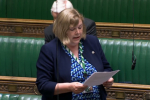Jane Hunt MP asked:
To ask the Secretary of State for Environment, Food and Rural Affairs, what steps the Government is taking to reduce levels of PM2.5 pollution (a) in total and (b) emitted from (i) existing and (ii) future incinerators.
Rebecca Pow MP, Parliamentary Under-Secretary, responded:
Our Clean Air Strategy, published in 2019, set out the comprehensive action required across all parts of Government and society to reduce our emissions of five key pollutants, including particulates, to meet legally binding targets for 2020 and 2030.
We are taking action now to deliver these commitments. For example, we recently passed legislation to phase out the sale of house coal and small volumes of wet wood for domestic burning across England – measures focused on tackling a key source of PM2.5.
Our landmark Environment Bill delivers key parts of the Strategy. It introduces a duty to set a legally binding target for fine particulate matter, in addition to a further long-term air quality target. In August, Government published a policy paper on environmental targets which outlined our objectives for air quality targets – to reduce the annual mean level of PM2.5 in ambient air and reduce population exposure to PM2.5 in the long-term.
Emissions from incinerators in England are regulated by the Environment Agency under environmental permits. Permits contain limits for total particulate matter (TPM) which includes particulates of all sizes, including PM2.5. All incinerator permits issued since 3 December 2019 have contained a lower daily average TPM limit of 5 mg/Nm3 (compared with permits issued before then for which the limit was 10 mg/Nm3). Permits for incinerators issued before 3 December 2019 will be changed to require compliance with the lower 5 mg/Nm3 limit by 3 December 2023. Operators must continuously monitor their TPM emissions and the Environment Agency carries out regular inspections and audits to ensure that plants are complying with their permits.

